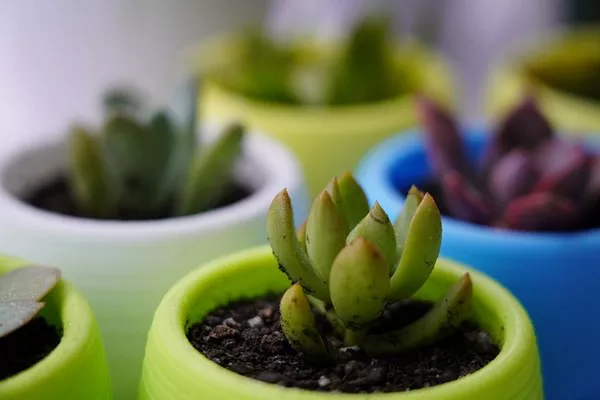Succulents, with their unique and captivating forms, have become increasingly popular as houseplants and outdoor ornaments. Their ability to thrive in arid conditions and survive with minimal care makes them an attractive choice for both novice and experienced plant enthusiasts. However, one phenomenon that can puzzle succulent growers is stretching or etiolation. In this article, we will delve into the reasons why succulents stretch, exploring the science behind etiolation and offering expert tips to prevent and manage this common issue.
Understanding Etiolation in Succulents
Etiolation is a natural response of plants, including succulents, to insufficient light conditions. It is a process in which plants elongate and grow taller, often appearing stretched and leggy. While succulents are hardy plants well-adapted to various environments, they have evolved to thrive in regions with abundant sunlight. When exposed to low light levels for an extended period, succulents exhibit etiolation as a survival mechanism to reach out for more light.
Etiolation can be particularly noticeable in indoor settings, where light levels are often lower than the intensity of natural sunlight. It is crucial to understand that etiolation is not a sign of poor health or disease; rather, it is a response to suboptimal growing conditions.
Light Requirements for Succulents
To grasp why succulents stretch, we must first explore their light requirements. Succulents are sun-loving plants that have adapted to thrive in bright, direct sunlight. In their natural habitats, they receive ample sunlight, allowing them to carry out photosynthesis efficiently and store water in their fleshy leaves and stems.
When grown indoors or in shaded areas, succulents do not receive the same intensity of sunlight they are accustomed to. As a result, they elongate their stems in an attempt to reach for more light, sacrificing their compact and robust appearance in the process.
Identifying Stretched Succulents
Recognizing etiolation in succulents is relatively straightforward. Stretched succulents display elongated stems with considerable space between leaves. The once compact and rosette-like shape becomes less pronounced, and the plant may appear top-heavy. Additionally, the leaves may lose their vibrant colors, becoming paler or even yellowish due to reduced chlorophyll production.
It is essential to identify etiolation early to address the issue promptly and prevent further stretching.
How to Prevent Etiolation in Succulents
Prevention is key when it comes to managing etiolation in succulents. By providing optimal growing conditions, you can help your succulents maintain their natural, healthy form.
Sunlight:
Place your succulents in a location that receives ample sunlight, preferably a spot with at least six hours of direct sunlight daily. If growing indoors, position them near a sunny window, south-facing if possible, to ensure they receive sufficient light.
Rotate Succulents:
Regularly rotate your potted succulents to ensure even exposure to sunlight. This helps prevent the plant from leaning towards the light source and encourages balanced growth.
Outdoor Cultivation:
If your climate allows, consider growing succulents outdoors, where they can bask in the natural sunlight. Outdoor conditions often provide more ideal light levels for succulent growth.
Artificial Lighting:
In situations where natural sunlight is limited, supplementing with artificial grow lights can be beneficial. LED grow lights, designed to emit the specific light spectrum that plants need for photosynthesis, can help prevent stretching in indoor succulents.
How to Revive Stretched Succulents
If you notice that your succulents have already stretched, there are steps you can take to rejuvenate them and encourage healthier growth.
Pruning: To rejuvenate a stretched succulent, consider pruning its elongated stems. Use clean and sharp scissors or pruning shears to cut the stems back to a more compact shape. This encourages the plant to redirect its energy to new growth points.
Propagation: After pruning, save the cuttings and propagate them to grow new succulent plants. Propagation from healthy cuttings ensures the next generation of succulents will maintain their natural, compact form.
Sunlight and Care: Once you have pruned and propagated, ensure the remaining plant receives optimal sunlight and care. Follow the preventive measures mentioned earlier to avoid further stretching.
Selecting the Right Succulents for Low-Light Environments
If you have limited access to direct sunlight, consider choosing succulent varieties that are better suited to low-light conditions. Some succulents, such as Sansevieria (Snake Plant) and Haworthia, are more tolerant of shade and can thrive in indoor settings with less sunlight. These varieties are excellent options for spaces where direct sunlight is scarce.
Conclusion:
Etiolation is a natural response of succulents to low light levels and does not indicate poor health or improper care. By understanding the light requirements of succulents and providing them with optimal growing conditions, you can prevent and manage stretching. Place your succulents in locations with ample sunlight, rotate them regularly, and consider using artificial grow lights when necessary. If your succulents have already stretched, pruning and propagation can help rejuvenate them and encourage healthier growth.
Remember that each succulent species has unique light preferences, so choose varieties that align with the light conditions in your environment. With proper care and attention, your succulents will thrive, maintaining their characteristic charm and beauty for years to come.


